Comparative Analysis of Power Consumption between MQTT and HTTP Protocols in an IoT Platform Designed and Implemented for Remote Real-Time Monitoring of Long-Term Cold Chain Transport Operations
Abstract
:1. Introduction
1.1. IoT Technology
1.2. Long-Term Cold Chain Transport Operations
Technical Challenges in Cold Chain Transportation
- Keeping devices connected as they move: A system’s architecture must be suited to managing bidirectional data transmission and intermittencies in network access when vehicles are in movement. Some IoT applications within cold chain transportation could require real-time data transmission over long distances.
- The implementation of embedded systems: Commonly, these kinds of devices have minimal resources, including low computation power. A lightweight and efficient protocol is required to optimize network bandwidth.
- Scalability: Broadcasting a message to or from many clients in real time is not an easy task. Additionally, it is hard to guarantee client–server connections when scaling up or down the number of devices connected to an IoT system.
- Reliable and secure data management: Identity, the encryption of messages, and authentication protocols must be used to protect data during the transmission process.
- Energy constraints: Even though at present, IoT platforms in the transportation industry are widely used, they have a big limitation with regard to power consumption, as most of them are planned to be portable. Coupled with this, a change of battery is needed at certain intervals of time, particularly for long-term monitoring.
1.3. Research Contribution
- The design and implementation of a cost-efficient IoT electronic platform for the remote real-time monitoring of long-term cold chain transport operations.
- The evaluation and validation of the performance, accuracy, and precision of the sensed variables in the electronic platform.
- A comparative analysis of the power consumption between two of the most used protocols in the IoT, namely, the Hypertext Transfer Protocol (HTTP) and Message Queue Telemetry Transport (MQTT). The analysis was performed with identical hardware to compare the HTTP client/server and MQTT publish/subscribe models. Moreover, the magnitude of the quality of service (QoS) using the MQTT protocol was valued as either 0 or 1.
- A prediction model for the life cycle of batteries in the implemented platform, according to its specifications for long-term tests.
2. Related Work
2.1. NodeMCU for IoT Applications
2.2. Power Consumption between HTTP and MQTT
3. IoT Application Layer Protocols
3.1. HTTP
Client/Server Architecture
3.2. MQTT Protocol
3.2.1. Publish/Subscribe Architecture
3.2.2. Broker
- Space: Subscribers and clients do not need to know the IPs of each other.
- Time: Clients do not have to be running at the same time.
- Synchronization: Publishing and receiving information can occur simultaneously, and this does not halt operations.
3.2.3. Quality of Service
- QoS 0: “At most once”. A message is sent only once, and whether the message was received by the client is not verified. This level is the simplest, but it is possible to lose packages of data.
- QoS 1: “At least once”. At level 1, a message is sent, and the delivery status is checked via the status check message, called the PUBACK. The broker stores messages and sends them until clients have acknowledged their delivery, but if a PUBACK is lost, duplicate messages are received by the client since there is no confirmation of delivery.
- QoS 2: “Exactly once”. Messages have a second acknowledgment round trip, having four interactions between the client and the broker to ensure that the messages are delivered only once. Message loss is not possible with QoS 2, but the process is more complicated and sometimes requires more time.
4. Material and Methods
4.1. Hardware
4.2. Measurement Equipment
Data Acquirer
- Signal conditioning: Physical signals are usually noisy, and they are not prepared for input into an ADC. Signal conditioning is a process that adapts signals to a required input range. This circuit can include amplification, attenuation, and filtering.
- Analog-to-digital converter (ADC): Analog signals from sensors are converted into digital signals before being sent to the computer. The communication between the DAQ system and the computer is digital, so the DAQ system carries out the procedure to transform analog signals into digital signals.
- PC bus: The communication between the DAQ and the PC is through a port where the bus works as a communication interface. The ADC makes periodic samples of the signal at a predefined rate, which are sent to the PC through the PC bus, where the original signal is reconstructed. The most common PC buses are USB and Ethernet.
4.3. Web Development Methodology (Front-End)
4.3.1. HTTP Dashboard
4.3.2. MQTT Dashboard
4.4. Web Development Methodology (Back-End)
4.4.1. Database
4.4.2. PHP
- “nodemcu.php”: This code was created to allow data visualization everywhere. With this code, a web server in the created domain is made to have the readings sent to the database only by accessing the right link.
- “post-nodemcu.php”: This code is in charge of publishing sensor readings to the MySQL database.
4.5. Measurement Methodology
5. System Prototype
Price
6. Results
6.1. Power Consumption of HTTP and MQTT with QoS 0 and 1
6.2. Normal and Real Distribution of Instantaneous Power Consumption
6.3. Prediction Model for Long-Term Tests
Relative Error between Theory and Experimentation
7. Conclusions and Future Work
- Develop new strategies for the detection of abnormalities in the parameters being monitored. New methodologies and systems need to consider the criteria to define abnormalities and detect whether transportation vehicles are in movement or not due to environmental conditions that could impact the desired range of values for temperature and humidity in products.
- Set the sampling rate according to the needs of the application, taking into consideration that the sampling frequency is proportional to the power consumption of any system. It would be valuable to increase the sampling period without altering the main functions of the electronic platform.
- Develop a hybrid IoT system capable of switching between the different levels of services in the MQTT message delivery quality of service according to the type of product, the environmental conditions, and the traffic within the cold supply chain.
- Leave out devices that are not indispensable to the performance of the system such as LCD, which is used for debugging purposes, and microSD memory, which can be substituted with the cloud database.
- Apply one of the multiple specialized methods and techniques to optimize code, which is intended to become smaller, executing tasks in a quicker way and performing fewer operations. With code optimization, the program is expected to consume less memory and the electronic system less power.
- Implementing cellular networks and analyzing the consumed power in the electronic platform.
- Fabricating the electronic platform in a PCB-Microelectro-Mechanical System (MEMS) to significantly reduce its size and make it more portable.
- Experimenting with different sampling rates to determine differences in power.
- Associating the data storage and databases with cloud providers such as Alibaba Cloud and Amazon Web Services, among others.
- Studying the differences in power consumption when varying many variables such as the time of data transmission, the number of subscribers/publishers in the system, and the number of sensors in wireless network nodes.
- Exploring other application layer protocols such as CoAP and WebSocket, which also have many uses in actual IoT applications.
Author Contributions
Funding
Institutional Review Board Statement
Informed Consent Statement
Data Availability Statement
Acknowledgments
Conflicts of Interest
References
- Xu, L.; McArdle, G. Internet of too many things in smart transport: The problem, the side effects and the solution. IEEE Access 2018, 6, 62840–62848. [Google Scholar] [CrossRef]
- Abraham, S.C. Internet of things (IoT) with cloud computing and machine-to-machine (M2M) communication. IJETST 2016, 3, 4654–4661. [Google Scholar] [CrossRef]
- Muthuramalingam, S.; Bharathi, A.; Rakesh Kumar, S.; Gayathri, N.; Sathiyaraj, R.; Balamurugan, B. IoT based intelligent transportation system (IoT-ITS) for global perspective: A case study. In Internet of Things and Big Data Analytics for Smart Generation; Kacprzyk, J., Lakhmi, C.J., Eds.; Springer International Publishing: Cham, Switzerland, 2019. [Google Scholar]
- Sherly, J.; Somasundareswari, D. Internet of Things based smart transportation systems. IRJET 2015, 2, 1207–1210. [Google Scholar]
- Xie, X. Key Applications of the Smart IoT to Transform Transportation Systems; In WIOMAX Report, Washington, USA. 2018. Available online: http://www.wiomax.com/doc/report/WIO-TR-18-001.pdf (accessed on 11 May 2023).
- Tadejko, P. Application of Internet of Things in logistics-current challenges. JEMI 2015, 7, 54–64. [Google Scholar]
- Trilles, S.; Torres-Sospedra, J.; Belmonte, O.; Zaragaza-Soria, F.J.; González-Pérez, A.; Huerta, J. Development of an open sensorized platform in a smart agriculture context: A vineyard support system for monitoring mildew disease. Sustain. Comput. Inform. Syst. 2020, 28, 100309. [Google Scholar] [CrossRef]
- Causevic, S.; Colakovic, A.; Haskovic, A. The model of transport monitoring application based on Internet of Things. In Proceedings of the International Scientific Conference on Science and Traffic Development, Opatija, Croatia, 10–11 May 2018. [Google Scholar]
- Davis, K.F.; Downs, S.; Gephart, J.A. Towards food supply chain resilience to environmental shocks. Nat. Food 2021, 2, 54–65. [Google Scholar] [CrossRef] [PubMed]
- Raak, N.; Symmank, C.; Zahn, S.; Aschemann-Witzel, J.; Rohm, H. Processing- and product-related causes for food waste and implications for the food supply chain. Waste Manag. 2017, 61, 461–472. [Google Scholar] [CrossRef]
- Pocas Ribeiro, A.; Rok, J.; Harmsen, R.; Rosales Carreón, J.; Worrell, E. Food waste in an alternative food network-a case-study. RCR Adv. 2019, 149, 210–219. [Google Scholar] [CrossRef]
- Gormley, R.; Brennan, M.; Butler, F. Upgrading the Cold Chain for Consumer Food Products; The National Food Centre, TEAGASC, Agriculture and Food Development Authority: Dublin, Ireland, 2000. [Google Scholar]
- Wang, J.; Wang, H.; He, J.; Li, L.; Shen, M.; Tan, X.; Min, H.; Zheng, L. Wireless sensor network for real-time perishable food supply chain management. Comput. Electron. Agric. 2015, 110, 196–207. [Google Scholar] [CrossRef]
- Tamplin, M.L. Integrating predictive models and sensors to manage food stability in supply chains. Food Microbiol. 2018, 75, 90–94. [Google Scholar] [CrossRef]
- ESP8266 Wi-Fi MCU, Espressif Systems. Available online: https://www.espressif.com/en/products/socs/esp8266 (accessed on 30 March 2023).
- Kaium Khan, A.; Ahmed Shaem, T.; Rahman, M.; Zowad Khan, A.; Shah Alamgir, M. A portable and less time consuming wireless biometric attendance system for academic purpose using NodeMCU microcontroller. In Proceedings of the 2018 21st International Conference of Computer and Information Technology (ICCIT), Dhaka, Bangladesh, 21–23 December 2018. [Google Scholar]
- Mahindar, R.; Prakash, M.; Ghosh, S.; Mukherjee, S.; Ghosh, R. IoT-based home appliances control system using NodeMCU and blynk server. Int. Adv. Res. J. Sci. Eng. Technol. 2018, 5, 16–22. [Google Scholar]
- Shelke, P.; Kulkarni, S.; Yelpale, S.; Pawar, O.; Singh, R.; Deshpande, K. A NodeMCU based home automation system. Int. Res. J. Eng. Technol. 2018, 5, 127–129. [Google Scholar]
- Chan May, O.A.; Sandoval Gio, J.; Peña Koo, J.J. Internet de las cosas para controlar el encendido y apagado de aires acondicionados y luminarias. Pist. Educ. 2016, 38, 100–119. [Google Scholar]
- Abdulahad Aziz, D. Webserver based smart monitoring system using esp8266 node mcu module. Int. J. Sci. Eng. Res. 2018, 9, 801–807. [Google Scholar]
- Chooruang, K.; Mangkalakeeree, P. Wireless heart rate monitoring system using mqtt. Procedia Comput. Sci. 2016, 86, 160–163. [Google Scholar] [CrossRef]
- Singh, B.; Urooj, S.; Mishra, S.; Haldar, S. Blood pressure monitoring system using wireless technologies. Procedia Comput. Sci. 2019, 152, 267–273. [Google Scholar] [CrossRef]
- Sachdev, S.; Macwan, J.; Patel, C.; Doshi, N. Voice-controlled autonomous vehicle using IoT. Procedia Comput. Sci. 2019, 160, 712–717. [Google Scholar] [CrossRef]
- Puñal Pereira, P. Efficient IoT Framework for Industrial Applications. Ph.D. Thesis, School of Industrial Electronics, Lulea, Sweden, 2016. [Google Scholar]
- Vergara, E.J.; Nadjm-Tehrani, S.; Prihodko, M. Energybox: Disclosing the wireless transmission energy cost for mobile devices. Sustain. Comput. Inform. Syst. 2014, 4, 118–135. [Google Scholar] [CrossRef]
- Luthfi, F.; Juanda, E.A.; Kustiawan, I. Optimization of data communication on air control device based on Internet of Things with application of http and mqtt protocols. In Proceedings of the IOP Conference Series: Materials Science and Engineering, Bandung, Indonesia, 16 November 2017. [Google Scholar]
- Naik, N. Choice of effective messaging protocols for IoT systems: MQTT, CoAP, AMQP and http. In Proceedings of the 2017 IEEE International Systems Engineering Symposium (ISSE), Vienna, Austria, 11–13 October 2017. [Google Scholar]
- Power Profiling: Https Long Polling vs. MQTT with ssl on Android. Available online: http://stephendnicholas.com/posts/power-profiling-mqtt-vs-https (accessed on 30 March 2023).
- Espinosa-Aranda, J.L.; Vallez, N.; Sanchez-Bueno, C.; Aguado-Araujo, D.; Bueno, G.; Deniz, O. Pulga, a tiny open-source mqtt broker for flexible and secure IoT deployments. In Proceedings of the 2015 IEEE Conference on Communications and Network Security (CNS), Florence, Italy, 28–30 September 2015. [Google Scholar]
- Veerasamy, B.D. Creating a model http server program using java. arXiv 2010, arXiv:1003.1497. [Google Scholar]
- Kumar, S. A review on client-server based applications and research opportunity. IJRSR 2019, 10, 33857–33862. [Google Scholar]
- Pastor-Vargas, R.; Tobarra, L.; Robles-Gómez, A.; Martin, S.; Hernández, R.; Cano, J. A wot platform for supporting full-cycle IoT solutions from edge to cloud infrastructures: A practical case. Sensors 2020, 20, 3770. [Google Scholar] [CrossRef] [PubMed]
- Happ, D.; Wolisz, A. Limitations of the pub/sub pattern for cloud based IoT and their implications. In Proceedings of the 2016 Cloudification of the Internet of Things (CIoT), Paris, France, 23–25 November 2016. [Google Scholar]
- Bryce, R.; Shaw, T.; Srivastava, G. MQTT-G: A publish/subscribe protocol with geolocation. In Proceedings of the 2018 41st International Conference on Telecommunications and Signal Processing (TSP), Athens, Greece, 4–6 July 2018. [Google Scholar]
- Lee, S.; Kim, H.; Hong, D.K.; Ju, H. Correlation analysis of mqtt loss and delay according to qos level. In Proceedings of the The International Conference on Information Networking 2013 (ICOIN), Bangkok, Thailand, 28–30 January 2013. [Google Scholar]
- Longo Imedio, J.E.L. Aplicación de Domótica en el Contexto de IoT. Master’s Thesis, Facultad de Informática, Madrid, España, 2019. [Google Scholar]
- Tena, A.R.; Kristensen, L.M.; Rutle, A. On modelling and validation of the MQTT IoT protocol for M2M communication. CEUR Workshop Proc. 2018, 2138, 99–118. [Google Scholar]
- Baranauskas, E.; Toldinas, J.; Lozinskis, B. Evaluation of the impact on energy consumption of mqtt protocol over tls. In Proceedings of the IVUS 2019 International Conference on Information Technologies, Kaunas, Lithuania, 25 April 2019. [Google Scholar]
- Viswanathan, A. Analysis of Power Consumption of the MQTT Protocol. Master’s Thesis, School of Information Sciences, University Park, PA, USA, 2017. [Google Scholar]
- Digital Transformation in Transportation and Logistics with IoT and MQTT. Available online: https://www.hivemq.com/solutions/transportation/digital-transformation-in-transportation-and-logistics-with-iot-and-mqtt/ (accessed on 30 March 2023).
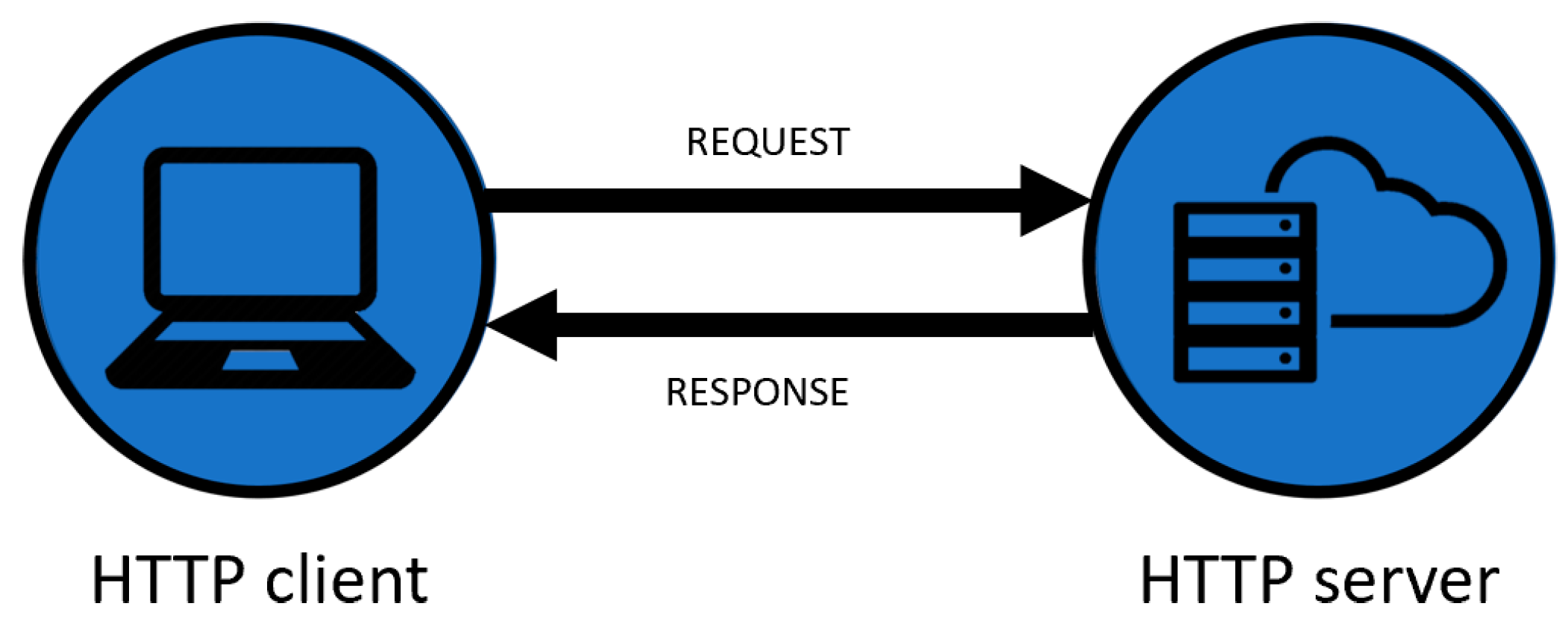




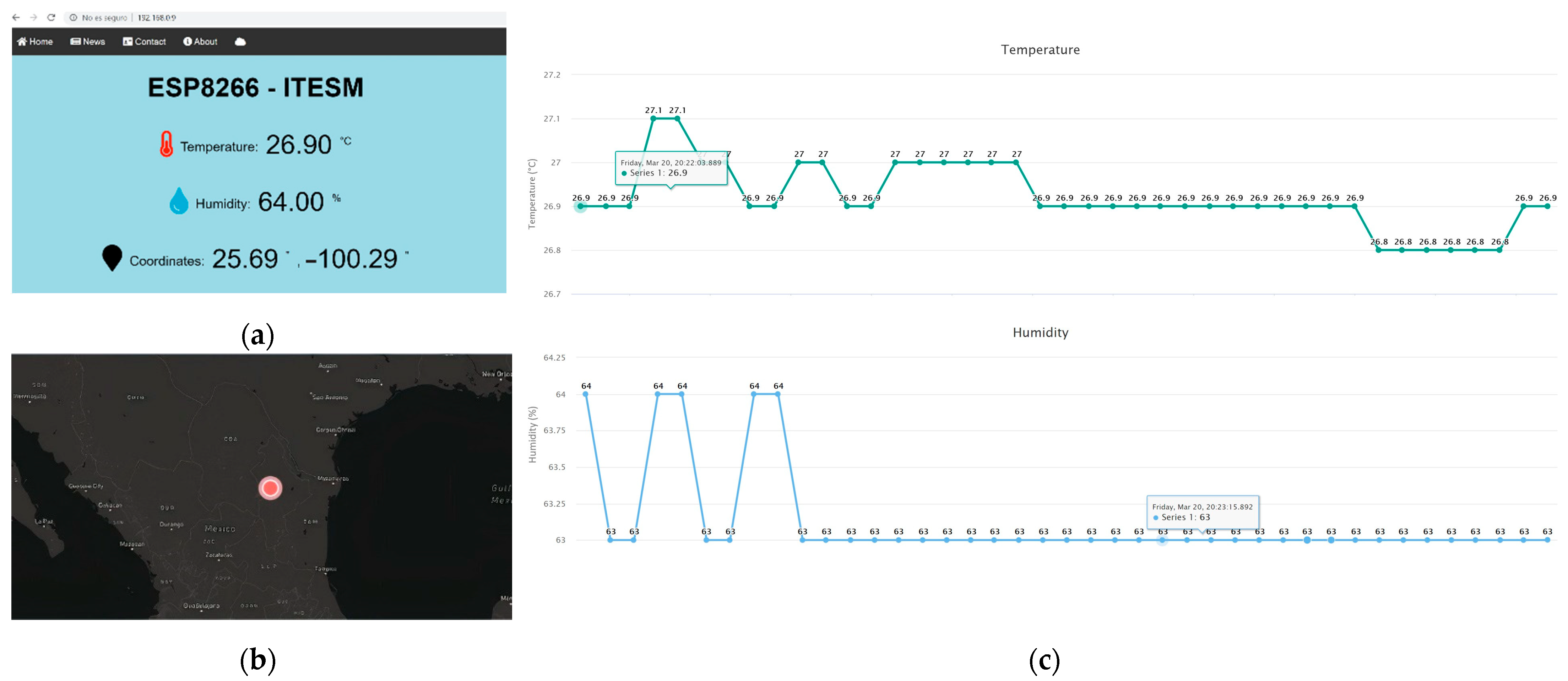



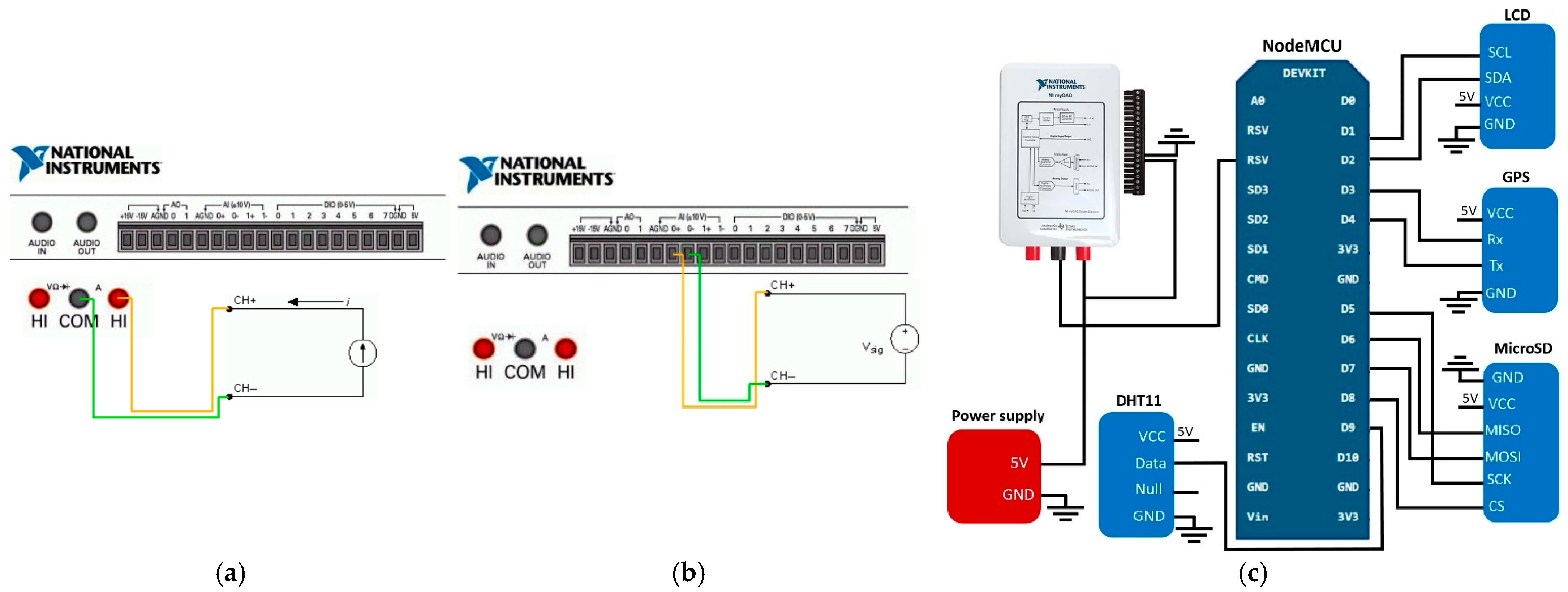
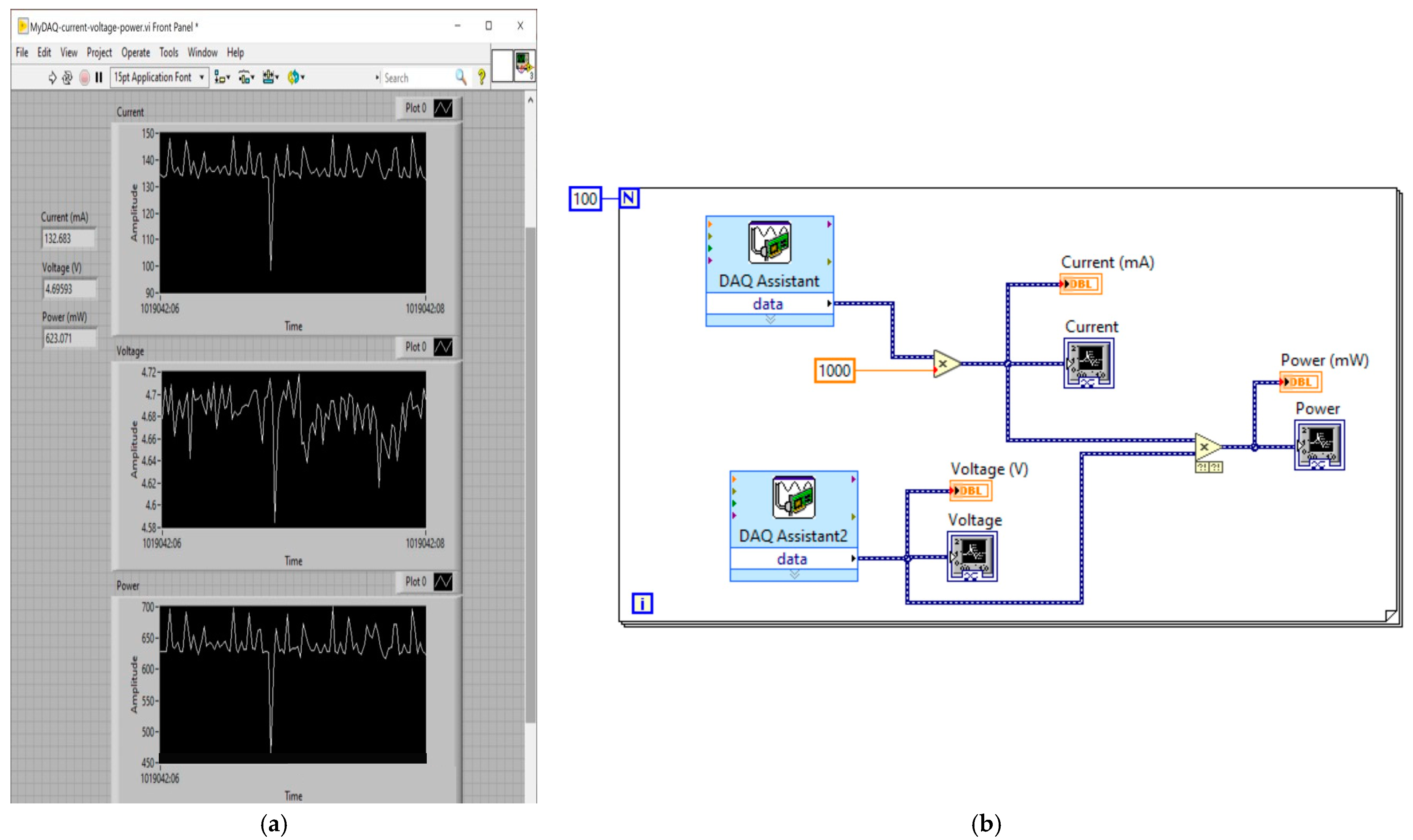
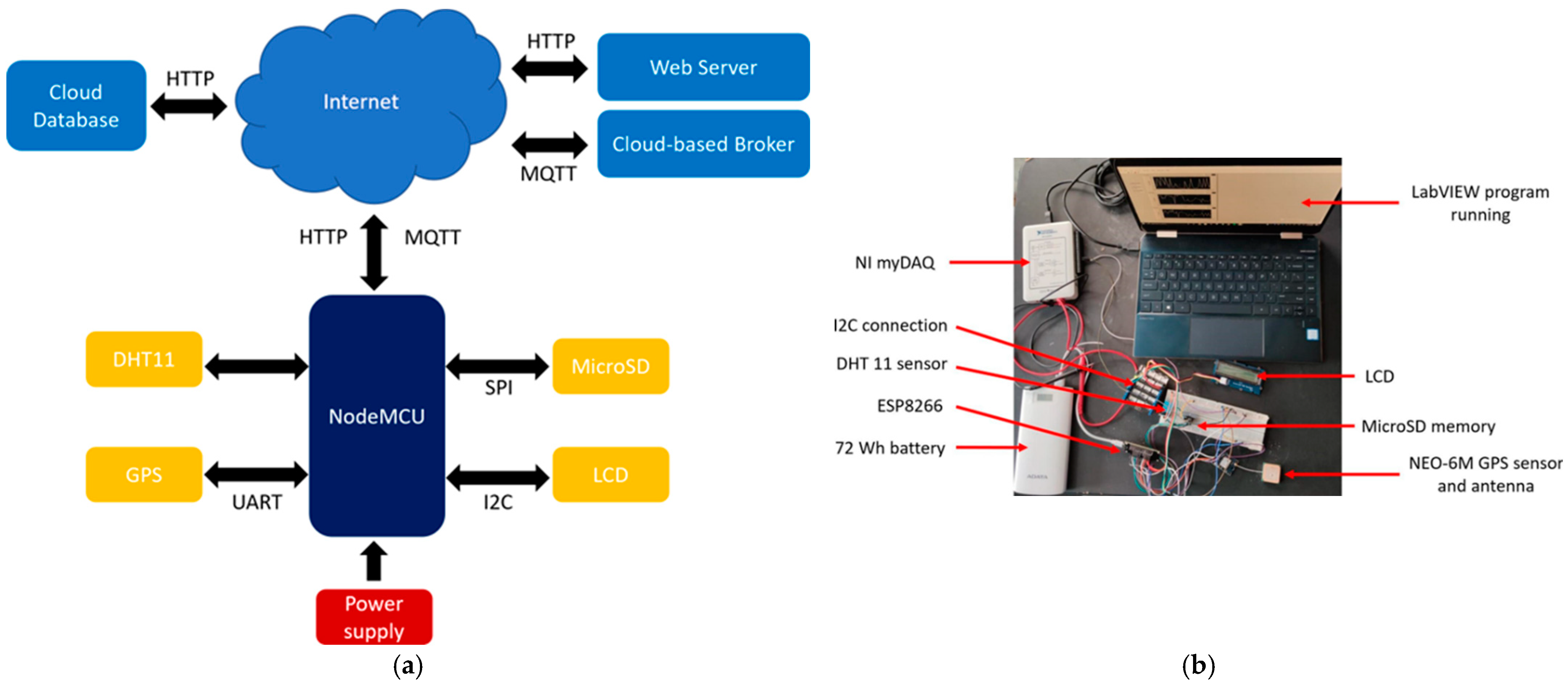
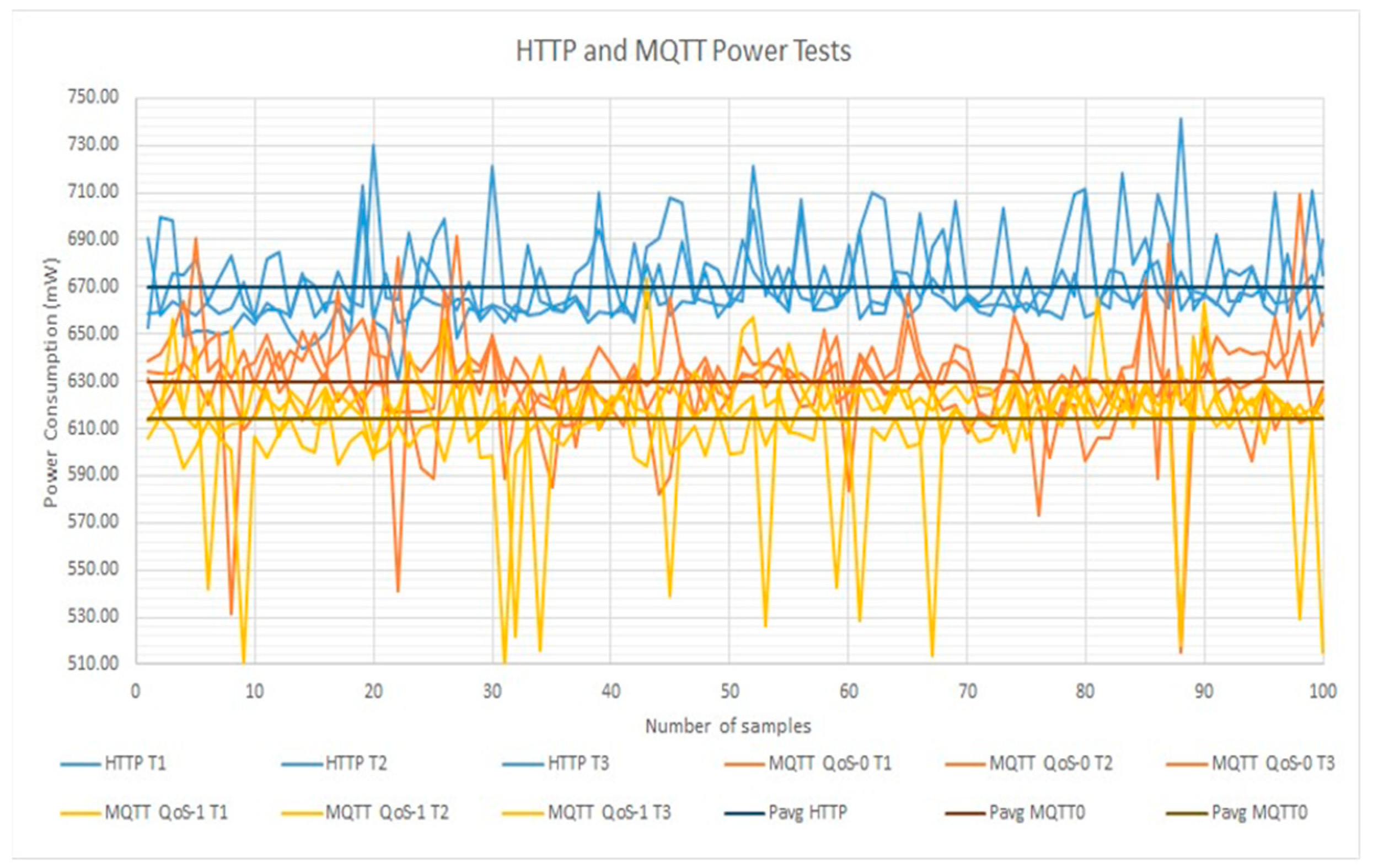

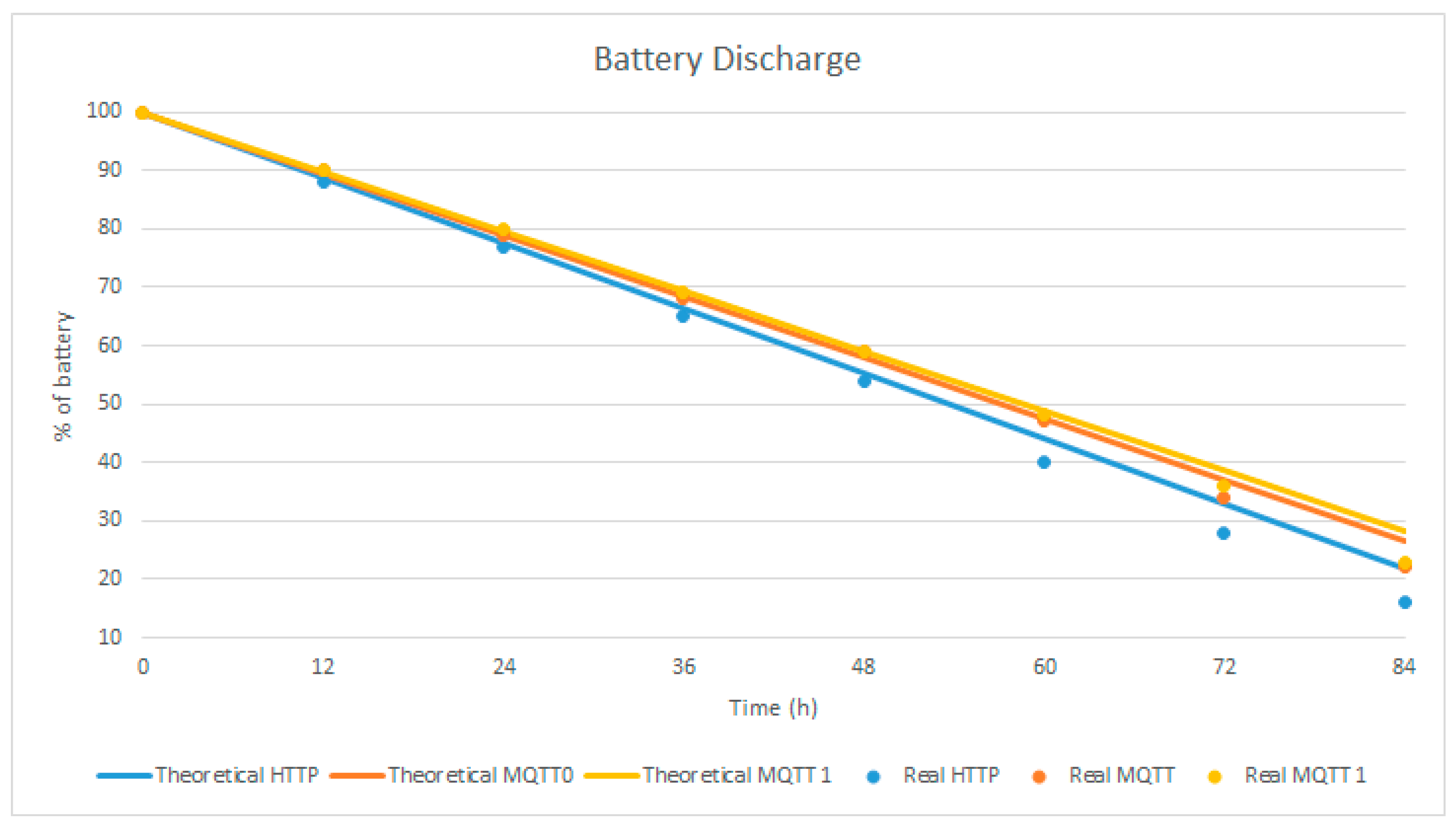
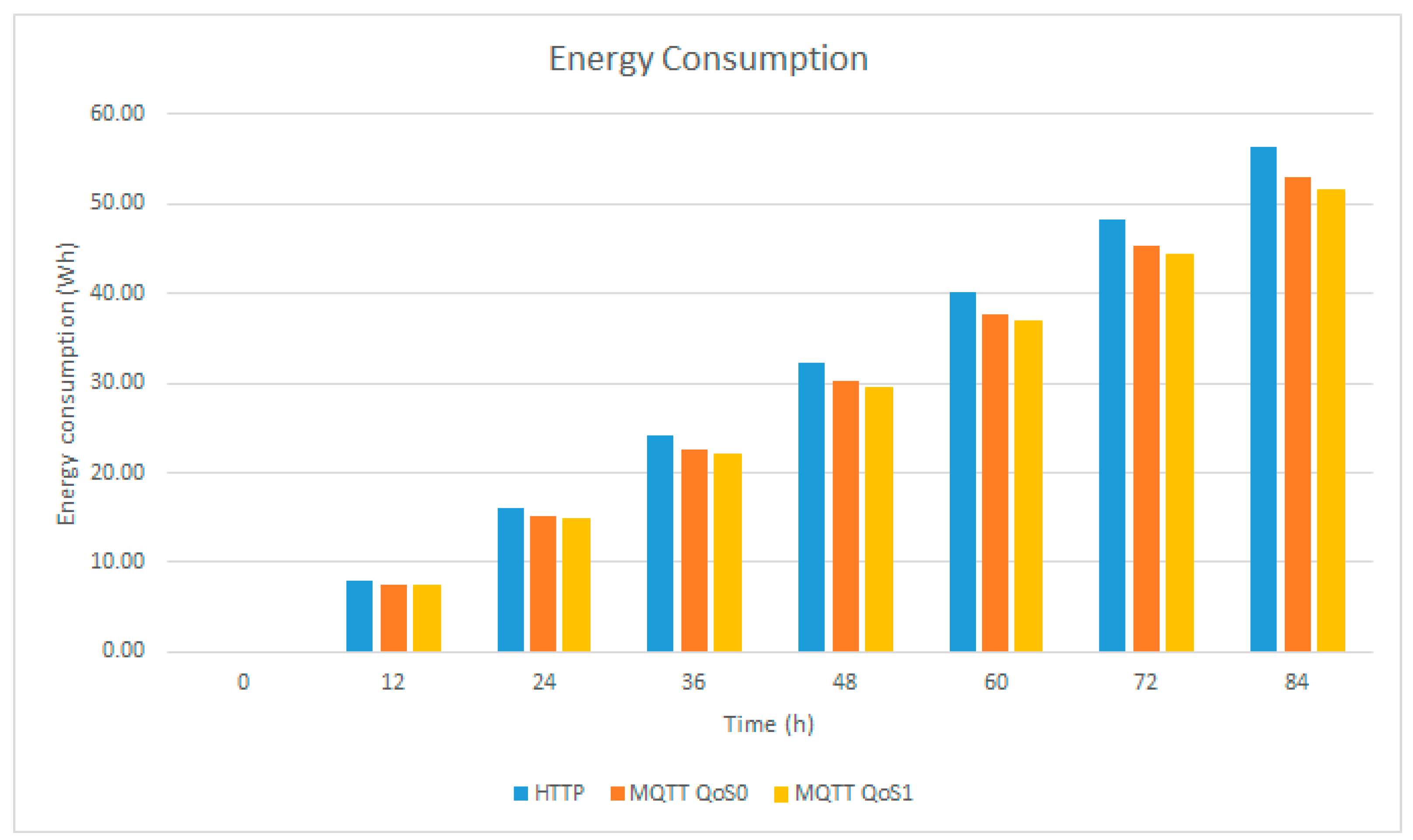

| # | Component | Unit Price (USD) 1 | Price (USD) 1 |
|---|---|---|---|
| 1 | NodeMCU | 2.00 | 2.00 |
| 1 | DHT11 temperature and humidity sensor | 0.77 | 0.77 |
| 1 | NEO 6M GPS sensor | 3.50 | 3.50 |
| 1 | MicroSD card adapter | 3.25 | 3.25 |
| 1 | 4GB SanDisk microSD card | 3.00 | 3.00 |
| 1 | Grove LCD RGB backlight | 9.09 | 9.09 |
| 1 | Breadboard | 1.00 | 1.00 |
| Total | 22.61 |
| Protocol | Description | Test | Imin | Imax | Iavg | Vmin | Vmax | Vavr | Pmin | Pmax | Pavg | σ | Energy |
|---|---|---|---|---|---|---|---|---|---|---|---|---|---|
| (#) | (mA) | (V) | (mW) | (J) | |||||||||
| HTTP | Only NodeMCU | 1 | 36.25 | 83.73 | 78.00 | 4.79 | 4.93 | 4.87 | 177.40 | 408.49 | 379.91 | 39.96 | 56.99 |
| 2 | 38.19 | 83.84 | 77.53 | 4.92 | 4.93 | 4.93 | 188.07 | 412.68 | 381.85 | 44.29 | 57.28 | ||
| 3 | 38.65 | 81.90 | 78.22 | 4.86 | 4.92 | 4.90 | 188.85 | 401.69 | 383.09 | 34.10 | 57.46 | ||
| Avg. | 37.70 | 83.16 | 77.91 | 4.85 | 4.93 | 4.90 | 184.77 | 407.62 | 381.62 | 39.45 | 57.24 | ||
| Complete system | 1 | 136.45 | 154.02 | 139.29 | 4.75 | 4.88 | 4.80 | 654.88 | 741.21 | 668.89 | 14.98 | 100.33 | |
| 2 | 137.25 | 150.26 | 142.05 | 4.51 | 4.76 | 4.72 | 630.55 | 711.82 | 670.07 | 18.56 | 100.51 | ||
| 3 | 136.79 | 152.88 | 140.20 | 4.74 | 4.86 | 4.79 | 664.59 | 664.73 | 671.52 | 15.04 | 100.73 | ||
| Avg. | 136.83 | 152.39 | 140.51 | 4.67 | 4.83 | 4.77 | 650.01 | 705.92 | 670.16 | 16.19 | 100.52 | ||
| MQTT QoS 0 | Only NodeMCU | 1 | 78.82 | 79.73 | 79.28 | 4.71 | 4.80 | 4.77 | 372.24 | 382.22 | 377.93 | 1.89 | 56.69 |
| 2 | 78.71 | 80.53 | 79.35 | 4.55 | 4.93 | 4.78 | 359.37 | 391.76 | 379.58 | 6.66 | 56.94 | ||
| 3 | 78.71 | 80.19 | 79.43 | 4.75 | 4.85 | 4.82 | 376.85 | 388.02 | 383.01 | 2.05 | 57.45 | ||
| Avg. | 78.74 | 80.15 | 79.35 | 4.67 | 4.86 | 4.79 | 369.49 | 387.33 | 380.17 | 3.53 | 57.03 | ||
| Complete system | 1 | 123.78 | 151.28 | 137.37 | 4.27 | 4.69 | 4.59 | 573.36 | 708.99 | 630.95 | 16.82 | 94.63 | |
| 2 | 136.11 | 150.83 | 139.42 | 4.24 | 4.64 | 4.53 | 583.48 | 691.75 | 631.81 | 19.84 | 94.78 | ||
| 3 | 112.26 | 142.61 | 136.32 | 4.41 | 4.69 | 4.60 | 515.07 | 663.91 | 626.39 | 21.54 | 93.96 | ||
| Avg. | 124.05 | 148.24 | 137.70 | 4.31 | 4.67 | 4.57 | 557.30 | 688.22 | 629.68 | 19.40 | 94.45 | ||
| MQTT QoS 1 | Only NodeMCU | 1 | 42.87 | 81.90 | 77.97 | 4.63 | 4.88 | 4.79 | 203.62 | 395.42 | 373.71 | 34.43 | 56.06 |
| 2 | 78.93 | 80.65 | 79.52 | 4.71 | 5.02 | 388.96 | 374.26 | 399.77 | 388.96 | 3.41 | 58.34 | ||
| 3 | 79.16 | 80.53 | 79.46 | 4.83 | 5.03 | 4.88 | 383.79 | 399.03 | 387.57 | 2.60 | 58.14 | ||
| Avg. | 66.99 | 81.03 | 78.99 | 4.72 | 4.98 | 132.88 | 320.56 | 398.07 | 383.41 | 13.48 | 57.51 | ||
| Complete system | 1 | 113.28 | 148.32 | 135.71 | 4.47 | 4.58 | 4.55 | 513.58 | 673.47 | 616.80 | 23.87 | 92.52 | |
| 2 | 114.88 | 144.21 | 136.32 | 4.46 | 4.57 | 4.53 | 522.25 | 657.26 | 618.11 | 21.37 | 92.72 | ||
| 3 | 113.28 | 143.41 | 135.28 | 4.41 | 4.59 | 4.50 | 509.55 | 649.26 | 608.08 | 21.55 | 91.21 | ||
| Avg. | 113.82 | 145.31 | 135.77 | 4.44 | 4.58 | 4.52 | 515.12 | 660.00 | 614.33 | 22.26 | 92.15 | ||
| Protocol | Pavg (mW) | σ (mW) | Battery Life (h) | σ (h) | %/h |
|---|---|---|---|---|---|
| HTTP | 670.16 | ± 16.19 | 107.44 | ± 2.59 | 0.9308 |
| MQTT QoS 0 | 629.68 | ± 19.39 | 114.34 | ± 3.52 | 0.8746 |
| MQTT QoS 1 | 614.33 | ± 22.25 | 117.20 | ± 4.24 | 0.8532 |
| Only NodeMCU | 381.73 | ± 18.81 | 188.61 | ± 9.29 | 0.5302 |
| Protocol | Min. | Max. | Average | σ | Variance | Median | Mode | Range |
|---|---|---|---|---|---|---|---|---|
| P (mW) | P (mW) | P (mW) | P (mW) | P (mW) | P (mW) | P (mW) | P (mW) | |
| HTTP | 643.74 | 741.21 | 670.29 | 16.13 | 260.06 | 664.25 | 659.24 | 97.46 |
| MQTT QoS 0 | 515.07 | 708.99 | 629.67 | 19.60 | 384.30 | 630.64 | 629.03 | 193.92 |
| MQTT QoS 1 | 509.55 | 673.47 | 614.33 | 22.69 | 515.05 | 616.85 | 626.00 | 163.92 |
| Hours | Theoretical (%) | Real (%) | Relative Error | ||||||
|---|---|---|---|---|---|---|---|---|---|
| HTTP | MQTT 0 | MQTT 1 | HTTP | MQTT 0 | MQTT 1 | HTTP | MQTT 0 | MQTT 1 | |
| 0 | 100 | 100 | 100 | 100 | 100 | 100 | 0 | 0 | 0 |
| 12 | 89 | 90 | 90 | 88 | 90 | 90 | 0.94 | 0.55 | 0.27 |
| 24 | 78 | 79 | 80 | 77 | 79 | 80 | 0.85 | 0.01 | 0.60 |
| 36 | 66 | 69 | 69 | 65 | 68 | 69 | 2.24 | 0.75 | 0.41 |
| 48 | 55 | 58 | 59 | 54 | 59 | 59 | 2.39 | 1.69 | 0.08 |
| 60 | 44 | 48 | 49 | 40 | 47 | 48 | 9.41 | 1.11 | 1.65 |
| 72 | 33 | 37 | 39 | 28 | 34 | 36 | 15.11 | 8.19 | 6.66 |
| 84 | 22 | 27 | 28 | 16 | 22 | 23 | 26.65 | 17.10 | 18.81 |
| Hours | Energy Consumption (Wh) | ||
|---|---|---|---|
| HTTP | MQTT QoS 0 | MQTT QoS 1 | |
| 0 | 00.00 | 00.00 | 00.00 |
| 12 | 08.04 | 07.56 | 07.37 |
| 24 | 16.08 | 15.11 | 14.74 |
| 36 | 24.13 | 22.67 | 22.12 |
| 48 | 32.17 | 30.22 | 29.49 |
| 60 | 40.21 | 37.78 | 36.86 |
| 72 | 48.25 | 45.34 | 44.23 |
| 84 | 56.29 | 52.89 | 51.60 |
Disclaimer/Publisher’s Note: The statements, opinions and data contained in all publications are solely those of the individual author(s) and contributor(s) and not of MDPI and/or the editor(s). MDPI and/or the editor(s) disclaim responsibility for any injury to people or property resulting from any ideas, methods, instructions or products referred to in the content. |
© 2023 by the authors. Licensee MDPI, Basel, Switzerland. This article is an open access article distributed under the terms and conditions of the Creative Commons Attribution (CC BY) license (https://creativecommons.org/licenses/by/4.0/).
Share and Cite
Jara Ochoa, H.J.; Peña, R.; Ledo Mezquita, Y.; Gonzalez, E.; Camacho-Leon, S. Comparative Analysis of Power Consumption between MQTT and HTTP Protocols in an IoT Platform Designed and Implemented for Remote Real-Time Monitoring of Long-Term Cold Chain Transport Operations. Sensors 2023, 23, 4896. https://doi.org/10.3390/s23104896
Jara Ochoa HJ, Peña R, Ledo Mezquita Y, Gonzalez E, Camacho-Leon S. Comparative Analysis of Power Consumption between MQTT and HTTP Protocols in an IoT Platform Designed and Implemented for Remote Real-Time Monitoring of Long-Term Cold Chain Transport Operations. Sensors. 2023; 23(10):4896. https://doi.org/10.3390/s23104896
Chicago/Turabian StyleJara Ochoa, Heriberto J., Raul Peña, Yoel Ledo Mezquita, Enrique Gonzalez, and Sergio Camacho-Leon. 2023. "Comparative Analysis of Power Consumption between MQTT and HTTP Protocols in an IoT Platform Designed and Implemented for Remote Real-Time Monitoring of Long-Term Cold Chain Transport Operations" Sensors 23, no. 10: 4896. https://doi.org/10.3390/s23104896
APA StyleJara Ochoa, H. J., Peña, R., Ledo Mezquita, Y., Gonzalez, E., & Camacho-Leon, S. (2023). Comparative Analysis of Power Consumption between MQTT and HTTP Protocols in an IoT Platform Designed and Implemented for Remote Real-Time Monitoring of Long-Term Cold Chain Transport Operations. Sensors, 23(10), 4896. https://doi.org/10.3390/s23104896








